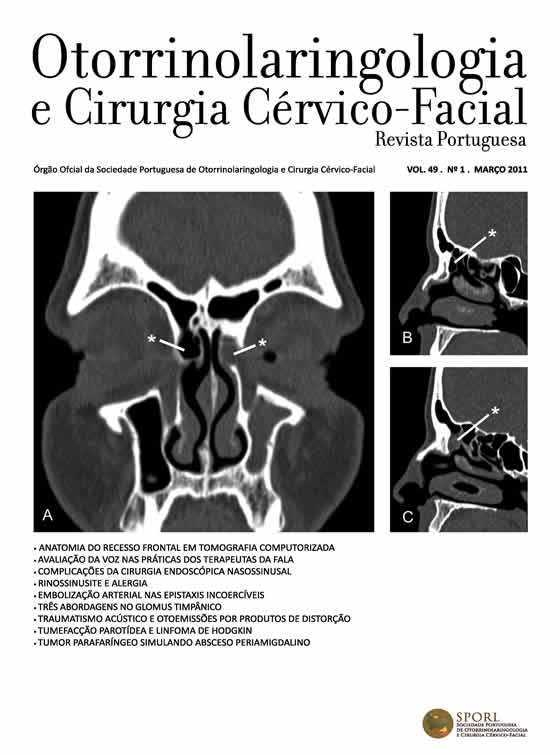Arterial embolizacion in the treatment of intractable epistaxis
DOI:
https://doi.org/10.34631/sporl.158Keywords:
Epistaxis, Supraselective embolizationAbstract
The aim of this work is to report our experience of supraselective embolization in the treatment of intractable epistaxis. We carry out a retrospective review of 13 patients, 11 men and two women, sent to the Vascular and Interventional Radiology Unit of the Otorhinolaryngology Department, between May 2002 and August 2008 for refractory epistaxis of the anteroposterior nasal packing, and who were treated with distal embolization of both internal maxillary arteries. In 12 patients (92%) nosebleeds did not return, and in one case (8%) the infiltration of the Etoxiesclerol post-embolization was necessary to control a new episode of epistaxis. Among the side-effects referred to, there was only one case of intense temporofacial pain following the endovascular procedure. We do a review of literature and present our conclusions.
Downloads
References
Andersen PJ, Drohse K A, Nepper-Rasmussen J. Selective Embolization in the treatment of intractable epistaxis. Acta Oto-Laryngologica 2005; 125:293-7.
Mahadevia A, Murphy K, Obray R, Gailloud P. Embolization for intractable epistaxis. Tech Vasc Interv Radiol 2005; 8:134-8.
Moreau S, De Rugy MG, Babin E, Courtheoux P, et al..Supraselective embolization in intractable epistaxis: review of 45 cases. Laryngoscope 1998; 108:887-8.
Elahi MM, Parnes LS, Fox AJ, Pelz DM, et al. Therapeutic embolization in the treatment of intractable epistaxis. Arch Otolaryngol Head and Neck Surg 1995; 121:65-69.
Vitek JJ. Idiopathic intractable epistaxis: endovascular therapy. Radiology 1991; 181:113-6.
Hernández JV, Ordóñez LE. Comparación del manejo quirürgico versus no quirürgico en pacientes con epistaxis posterior. Acta Otorrinolaringol Esp 2006; 57:41-46.
Oguni T, Korogi Y, Yasunaga T, SadanagaT, et al.. Superselective embolisation for intractable idiopathic epistaxis. The British Journal of Radiology 2000; 73:1148-53
Frikart, L; Agrifoglio, A. Endoscopic treatment of posterior epistaxis. Rhinology 1998; 36: 59-61.
Heermann H. Endonasal surgery with the use of the binocular Zeiss operating microscope. Arch Klin Exp Ohren Nasen Kehlkopfheilkd.1958; 171:295-297.
Heermann J. Intranasales mikrochirurgikes vorgehen bei epistaxis der riechspalte und weitere eingreffe mit hypotension.1986; HNO 34:208-215.
Heermann J, Neues D. Intranasal microsurgery of all paranasal sinuses, the septum, and the lacrimal sac with hypotensive anesthesia. Ann Otol Rhinol Laryngol 1986; 35:631-638.
Legent F, Boutet JJ, Wesolouch, VialeM, et al.. Treatment chirurgical des epistaxis. Interét de la micro-chirurgie endo-nasale. Rev Laryngol Otol Rhinol (Bord) 1986; 107:31-33.
Ruiz TG, Ugena RE, Palomino GA, Hernandez PC, et al..Aspectos prácticos sobre el tratamiento endoscopico de la epistaxis. Acta Otorrinolaringol Esp 2006; 57(9): 394-400.
Ugena RE, Ruiz TG, DomInguez AJ, Claver CF, et al.. Utilidad del tratamiento quirürgico de la epistaxis grave mediante abordaje endoscopico de las arterias esfenopalatina y etmoidal anterior. Acta Otorrinolaringol Esp 2006; 57(5): 228-234.
Sokoloff J, Wickbom I, McDonald D, F. Brahme, et al.. Therapeutic percutaneous embolization in intractable epistaxis. Radiology 1974; 111:285-7.
Schaitkin B, Strass M, Houck JR, Hershey P, et al.. Epistaxis: medical versus surgical therapy: a comparison of efficacy, complications, and economic considerations. Laryngoscope 1987; 97:1392-96.
Tan LK, Calhoun KH.Epistaxis. Med Clin North Am 1999; 83: 43-56.
Chandler JR, Serrins AJ. Transantral ligation of the internal maxillary artery for epistaxis. Laryngoscope 1965;75:1151-9.
Metson R, Lane R. Internal maxillary artery ligation for epistaxis: an analysis of failures. Laryngoscope 1988; 98:760-4.
Strother CM, Newton TH. Percutaneous embolization to control epistaxis in Rendu-Osler-Weber disease. Arch Otolaryngol 1976; 102:58-60.
Tseng EY, Narducci CA, Willing SJ, Sillers M J. Angiographic embolization for epistaxis: a review of 114 cases. Laryngoscope 1998;108:615-9.
Christensen NP, Smith DS, Barnwell SL, Wax MK. Arterial Embolization in the Management of Posterior Epistaxis. Otolaryngol Head Neck Surg 2005; 133:748-53
Stamm AC, Ferreira G, Navarro J A, Freire LAS. Severe epistaxis: Microendoscopic Surgical Techniques. In: Micro-endoscopic Surgery of the Paranasal Sinuses and the Skull Base. Berlin; Springer. 2000:pp.393-403.
Koh E, Frazzini VI, Kagetsu NJ. Epistaxis: Vascular Anatomy, Origins and Endovascular Treatment. Am J Roentgenol 2000; 174: 845-851.






